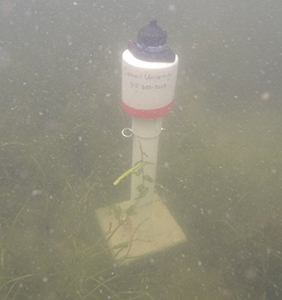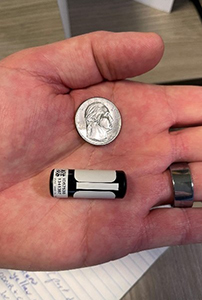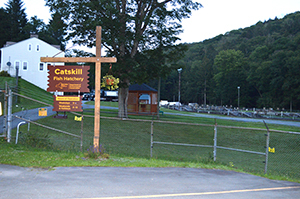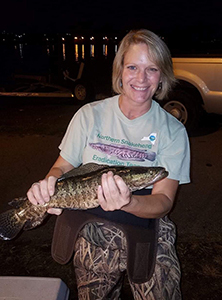Freshwater Fishing, Fisheries Management, and Fishing Access News
In This Issue:
- Oneida Lake Walleye Telemetry Study
- Take Your Fisheries Know-How to the Next Level
- Highlight Hatchery - Catskill Fish Hatchery
- Fisheries Staff Spotlight - Heidi O'Riordan, Regional Fisheries Manager
 Oneida Lake Walleye Telemetry Study Oneida Lake Walleye Telemetry Study
This fall the Cornell Biological Field Station in partnership with DEC will be initiating a 3-year telemetry study of adult walleyes in Oneida Lake to:
- identify spawning sites
- describe seasonal movement patterns
- describe habitat use throughout the year
- determine where post-spawn walleye go after they have been processed at the Oneida Fish Hatchery
Sixty-four acoustic receivers (pictured to the right) will be spaced throughout the lake and select tributaries to track the movement of 200 adult walleyes surgically implanted with acoustic transmitters (pictured at bottom right). Transmitters will send out a unique signal every 4 minutes and receivers in the vicinity will record the occurrence. Unless they leave the system, die naturally, or are harvested, walleyes will be tracked year-round during the study.
 If you harvest a walleye that has a transmitter, please use the contact information printed on the transmitter to facilitate its return. If you harvest a walleye that has a transmitter, please use the contact information printed on the transmitter to facilitate its return.
Data from receivers will be downloaded annually beginning in the summer of 2024. This study is part of the GLATOS (Great Lakes Acoustic Telemetry Observation System) network which gives us access to state-of-the-art analysis tools and expertise as well as inform us on fish tagged in Oneida Lake that may leave the system and enter the Great Lakes. This new information on movements and habitat use of the Oneida Lake walleye population will help DEC better manage this important and valuable resource. This is a Federal Aid in Sportfish Restoration project supported by your purchase of fishing licenses, fishing equipment, and motorboat fuels.
 Fisheries Management - Next Level Know-How for Anglers Fisheries Management - Next Level Know-How for Anglers
Every year DEC Bureau of Fisheries staff conduct hundreds of surveys throughout the state to evaluate fish populations for general status, potential enhancement or restoration. After which, they assess the data they collected and write a report based on their analyses. These reports not only offer a glimpse into what our work entails, but also shows how most fisheries management ultimately ties to recreational angling.
You can find a report based on geographic region or species by visiting our Fisheries Management and Research webpages.
 Highlight Hatchery - Catskill Fish Hatchery Highlight Hatchery - Catskill Fish Hatchery
Location: 402 Mongaup Rd. Livingston Manor, NY 12758. Exit 96 off Route 17, follow signs for Mongaup State Campground
Visitor Hours: 8:00 a.m. to 3:00 p.m., year round
Species Raised: Brown Trout
Overview: From the third week of August through early September, staff collect over 2 million eggs from brown trout broodstock and ship them out to other DEC hatcheries to be reared, then stocked. After egg quotas are met, broodstock are stocked in waters in Delaware, Sullivan and Orange counties. The facility is located adjacent to two prized fly fishing waters; the Willowemoc Creek and Beaverkill. The hatchery will begin its annual egg collection beginning on Tuesday, August 22 at 9:00am and the next 3-4 Tuesdays after until they reach their 2 million egg quota. Visitors welcome!
Fun Fact: The original piping that brought water from Mongaup Creek to the Hatchery was wooden wrapped with metal bands.
Visit a DEC Fish Hatchery
 Fisheries Staff Spotlight - Heidi O'Riordan, Regional Fisheries Manager Fisheries Staff Spotlight - Heidi O'Riordan, Regional Fisheries Manager
I started my career with DEC in 1997 in the Division of Marine Resources working with striped bass and American eel as a seasonal and eventually Fish & Wildlife Technician 2. I then had a brief position with the Division of Water in Region 3 (southeastern NY) inspecting sewage treatment plants for their effluent. The commute from Long Island was tough, so when a Biologist positioned opened up in Marine Resources at Stony Brook I was excited. I did permitting for tidal wetland habitat for a few years until a Biologist position opened in freshwater. I had already worked with freshwater fisheries as early as high school when I volunteered at Cold Spring Harbor Fish Hatchery and Aquarium assisting on the collection of native species for the display tanks. I also volunteered with the DEC Freshwater Fisheries Unit on electrofishing surveys. As a child I wanted to be the next Jacques Cousteau so getting to work with fish as a biologist has been a dream come true. As a native Long Islander I feel a very strong sense of stewardship to my island and our resources. I've been a manager for Region 1 Freshwater Fisheries for a few years now, have worked through the COVID years and I look forward to whatever is to come. I love being a department employee and I feel fortunate to be able to do what I love, working with other environmentalists and know we can make a difference.
On the personal side of my life, I have twins about to go to college for art and mechanical engineering. I am engaged and have a 23-year-old stepson. I love anything outdoors (especially the beach), traveling, my garden and my three dogs. I also love working on my house and being creative with art and nature. I enjoy painting, sculpting, wood working, any type of crafting. Looking to make the world look a little more beautiful and working to protect the natural beauty of what we already have.
|


 Oneida Lake Walleye Telemetry Study
Oneida Lake Walleye Telemetry Study If you harvest a walleye that has a transmitter, please use the contact information printed on the transmitter to facilitate its return.
If you harvest a walleye that has a transmitter, please use the contact information printed on the transmitter to facilitate its return. Fisheries Management - Next Level Know-How for Anglers
Fisheries Management - Next Level Know-How for Anglers Highlight Hatchery - Catskill Fish Hatchery
Highlight Hatchery - Catskill Fish Hatchery Fisheries Staff Spotlight - Heidi O'Riordan, Regional Fisheries Manager
Fisheries Staff Spotlight - Heidi O'Riordan, Regional Fisheries Manager